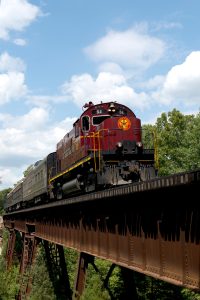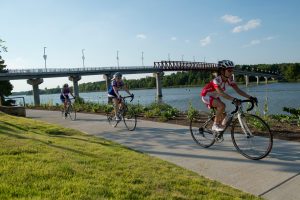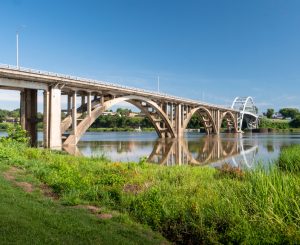Arkansas River Connection Project – Connecting Trails, Rail, and Water Based Transportation to Create New Economic Opportunity
BLOCK STREET & BUILDING VOLUME 8 2022
BY GREG NABHOLZ
In 2004, I — along with a group of dedicated economic and tourism leaders from Northwest Arkansas, the Arkansas River Valley, Central Arkansas and Southeast Arkansas launched an effort to look at how the Arkansas River and trail systems, railways, scenic byways, airports and other transportation hubs adjacent to and/or intersecting with the Arkansas River could be integrated in such a way that an entire new tourism experience and economic development tool for the state could be utilized.
In 2006, Arkansas River Connection was named and organized as a 501(c)(6), a mission has formally adopted and funds were raised for the first phase of a master plan study to identify all the assets that existed along a corridor where the river and its connections spanned. The mission of the organization is to analyze and connect tourist, recreational and entertainment attractions along the Arkansas River using multimodal forms of transportation for the purpose of expanding economic development and improving the quality of life.
The name includes “Arkansas River” because it is the primary focus and backbone of this project. “Connection” refers to linking the cities, towns and counties along the Arkansas River and other navigable waterways. Two of those waterways are the White and Mississippi rivers, accessible from the Arkansas River as well as accessible to cities and counties through other transportation means — i.e. Arkansas-Missouri Railroad’s excursion passenger train in Northwest Arkansas and trail systems such as the Arkansas River Trail in Central Arkansas and the Delta Heritage Trail in Southeast Arkansas. “Connection” also denotes unification for Northwest Arkansas, Arkansas River Valley, Central Arkansas, East Arkansas and Southeast Arkansas.
 The first phase of a master plan was funded and completed in 2007. A database was created allowing users to easily search for business listings, tourist attractions, recreational venues, events and other tourism-related information for locations near the Arkansas River and its identified rail and trail connections. What was clear from the first phase of the study is that the number of these attractions, venues and events was immense, providing for almost every type of recreational or leisure activity a person might want to enjoy. Because almost all were located within a short walkable or bikeable distance to the Arkansas River or its connections, just by developing new or integrating existing intersection points where trails, rail and the rivers met into transportation hubs, the infrastructure would be there to link all these attractions and create new tourism experiences.
The first phase of a master plan was funded and completed in 2007. A database was created allowing users to easily search for business listings, tourist attractions, recreational venues, events and other tourism-related information for locations near the Arkansas River and its identified rail and trail connections. What was clear from the first phase of the study is that the number of these attractions, venues and events was immense, providing for almost every type of recreational or leisure activity a person might want to enjoy. Because almost all were located within a short walkable or bikeable distance to the Arkansas River or its connections, just by developing new or integrating existing intersection points where trails, rail and the rivers met into transportation hubs, the infrastructure would be there to link all these attractions and create new tourism experiences.
One example of the numerous experiences is summed up best in the opening paragraph of an article where I was interviewed about the ARC project by Roby Brock in the 2008 edition of Talk Business Quarterly magazine titled “The Arkansas River Connection”: “It’s a glorious fall weekend in Arkansas. The Razorbacks are playing a Saturday night football game in Fayetteville. From Little Rock, you and your spouse decide to take off from work Friday, catch a boat ferry up the Arkansas River to the wine country in Altus. By afternoon, you are sampling vineyard vintage creations. Then upriver to Van Buren, where you’ll port at the marina and stay in an area hotel or bed & breakfast for the evening. You sample the local music scene in Fort Smith that night after throwing back a couple of cold ones and dogging on a plate-sized mega-burrito at Rolando’s on Garrison Avenue. The next morning brings some light shopping up and down Main Street in Van Buren before catching a train ride through the color-bursting Ozark Mountains to Fayetteville in advance of tailgating with local friends before the game. The Hogs whip Alabama by four touchdowns, which makes the rest of the night on Dickson Street one for the ages. Back to your hotel for some shut-eye. The next morning, you sleep in, have a late breakfast, and begin the return trip by rail and by river. Sound like a pipe dream? Maybe the Alabama beatdown. But the rest of the scenario is moving toward reality.”
In 2011, a flotilla organized by ARC spanning the entire Arkansas River brought great publicity to the ARC Project and the initiatives for some of the individual developments that were in motion. ARC also was instrumental in getting legislation passed that provided for public-private partnerships for rail, trail and water-based transportation. It was also during this time that the Delta Project — an initiative spearheaded by former Gov. Mike Beebe to connect communities via trails, byways and the Mississippi and White rivers — that ARC formally incorporated those plans into its mission.
 The second phase of the master plan — which remains uncompleted — is to identify the missing pieces needed to complete the infrastructure necessary for the multimodal transportation hubs and generate the financing to support it. This includes new and upgraded transient docks and marinas along the rivers as well as rail, trail, streetcar and public transportation upgrades and stops. Another aspect of the plan would be to identify and eliminate major obstacles.
The second phase of the master plan — which remains uncompleted — is to identify the missing pieces needed to complete the infrastructure necessary for the multimodal transportation hubs and generate the financing to support it. This includes new and upgraded transient docks and marinas along the rivers as well as rail, trail, streetcar and public transportation upgrades and stops. Another aspect of the plan would be to identify and eliminate major obstacles.
The largest infrastructure need identified by the ARC board was and still is to get a fueling dock in the area where the White and Arkansas rivers meet. Due to the fact that the last place to get fuel for boats traveling up the Mississippi River is Greenville, Mississippi, and down the Mississippi River is Memphis and sometimes Helena-West Helena and the first place to get fuel on the Arkansas River is Little Rock, there is a fuel desert that prohibits most boats from making it up the Arkansas River. It was estimated in 2012 that if the state invested $200,000 to build a 10-foot-by-160-foot dock with a fuel pump next to Arkansas Post State Park near the White-Arkansas River confluence and the Department of Parks and Tourism created a “River Trail” ad campaign like the “Golf Trail” and “Holiday Light Trail” ads, more than $10,000,000 in state tax revenue would be generated. One of the biggest obstacles identified was the red tape involved in trying to negotiate locations for transient docks and marinas with federal and state agencies and railroads on a site-by-site basis.
Obstacles aside, much of the missing connecting infrastructure that did not exist when ARC was formed has been developed thanks in part to the Walton Family Foundation and federal, state and local infrastructure grants. In 2015, the Razorback Greenway, the 38-mile backbone of a trail system from Fayetteville to Bella Vista that links over 100 miles of local and regional trails in Washington and Benton counties, was dedicated. In 2016, the Big River Crossing bike and pedestrian bridge linking Memphis and West Memphis was opened. The Big River Trail and Delta Heritage Trail are fully funded and when completed will create 215 miles of continuous trail in the Arkansas Delta. In 2018, the Arkansas Missouri Railroad received a federal infrastructure grant to rebuild three bridges, including one spanning the Arkansas River, that will allow more passenger excursion trips to Fort Smith. Master plans for both downtown Rogers and downtown Fort Smith incorporated upgraded rail stops and locations for transient docks and a marina, respectively. The Arkansas River Trail in Central Arkansas is being expanded to include other cities in the metro area. The Southwest Trail, a 75-mile trail along an abandoned railroad line connecting the Arkansas River Trail in Little Rock to Downtown Hot Springs, is under development. Two full-service marinas, Rockwater (downtown North Little Rock) and Rock City Yacht Club, (downtown Little Rock) have also been built. 
Now more than ever is an opportunity for The Natural State to move forward with the ARC Project as it was originally envisioned. There is a state budget surplus, federal infrastructure funds, economic development tools and public-private partnership financing that can all be used to fund completion of the plan. ARC as an organization can be an advocate, but this needs to be led by the governor’s office. The immediate step would be twofold: to release the funds and work through the appropriate state agency to get the fuel dock in place in Southeast Arkansas and to promote traveling on the river. The next step would be to form a partnership between all the state agencies involved with transportation, economic development, local and regional tourism and economic development organizations; and nonprofit foundations and the private sector need to create and execute a master plan.
Greg Nabholz is CEO of Nabholz Properties Inc. and a placemaking economic development consultant.
Photos Courtesy of Arkansas Department of Parks, Heritage, and Tourism
 The first phase of a master plan was funded and completed in 2007. A database was created allowing users to easily search for business listings, tourist attractions, recreational venues, events and other tourism-related information for locations near the Arkansas River and its identified rail and trail connections. What was clear from the first phase of the study is that the number of these attractions, venues and events was immense, providing for almost every type of recreational or leisure activity a person might want to enjoy. Because almost all were located within a short walkable or bikeable distance to the Arkansas River or its connections, just by developing new or integrating existing intersection points where trails, rail and the rivers met into transportation hubs, the infrastructure would be there to link all these attractions and create new tourism experiences.
The first phase of a master plan was funded and completed in 2007. A database was created allowing users to easily search for business listings, tourist attractions, recreational venues, events and other tourism-related information for locations near the Arkansas River and its identified rail and trail connections. What was clear from the first phase of the study is that the number of these attractions, venues and events was immense, providing for almost every type of recreational or leisure activity a person might want to enjoy. Because almost all were located within a short walkable or bikeable distance to the Arkansas River or its connections, just by developing new or integrating existing intersection points where trails, rail and the rivers met into transportation hubs, the infrastructure would be there to link all these attractions and create new tourism experiences. The second phase of the master plan — which remains uncompleted — is to identify the missing pieces needed to complete the infrastructure necessary for the multimodal transportation hubs and generate the financing to support it. This includes new and upgraded transient docks and marinas along the rivers as well as rail, trail, streetcar and public transportation upgrades and stops. Another aspect of the plan would be to identify and eliminate major obstacles.
The second phase of the master plan — which remains uncompleted — is to identify the missing pieces needed to complete the infrastructure necessary for the multimodal transportation hubs and generate the financing to support it. This includes new and upgraded transient docks and marinas along the rivers as well as rail, trail, streetcar and public transportation upgrades and stops. Another aspect of the plan would be to identify and eliminate major obstacles.
